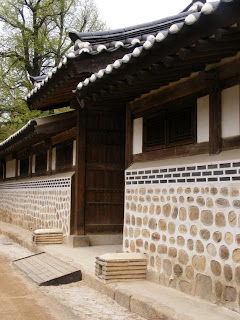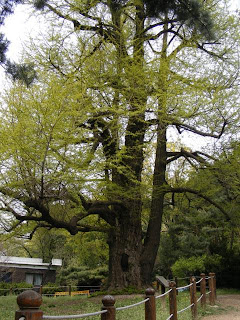On a radius of 40 km, around Gyeongbok Palace, there are 40 tombs of kings and queens of the Joseon dynasty. They all have been entered into the UNESCO heritage on 2009.
The royal tombs are under the etiquette of the Confucianism and respect the feng shui principles.
This means they have 3 parts: a gate, usualy red, a Korean type of hall, T-shaped, for rituals and the grave, surrounded by statues of soldiers and public servants, and of animals. Behind them it is a hill, for protection reasons, and it is always a running water in front of them for the energy flow.
I decided to visit Seonjeongneung, a complex with two parts, Seolleung and Jeongneung, belonging to two king and one queen. One king is Seongjong, and his wife the queen Jeonghyeon, and the king Jungjong (photos presented in this order). They are in a park with red pines, in the middle of a modern neighborhood. Access is possible to the first king’s tomb only. One may take photos of the other two tombs using zoom. Glimpses over the city are possible, when walking in the park.
I was impressed by the way the park and the tombs are taken care of.
My visit to these royal tombs completed my image about the Joseon era, together with what I learned visiting palaces, temples and old hanok houses. Together, all these impressions make connection between the old history and the present of the modern Seoul.
Pe o raza de 40 km in jurul Palatului Gyeongbok se afla 40 de morminte ale regilor si reginelor apartinand dinastiei Joseon. Acestea au fost cuprinse, toate, in patrimoniul UNESCO in 2009.
Felul in care sunt construite aceste adevarate monumente indica influenta etichetei confucianismului si a feng shui-ului. Conform acestei etichete, fiecare mormant este alcatuit din trei parti: o poarta de intrare, rosie, si un pod de piatra, care poate fi simbolizat si de o alee de piatra, impartita in doua: pe o parte are dreptul sa paseasca doar regele, pe cealalta, doar spiritele; un loc unde se oficiaza ritualurile, de obicei o structura in stil corean, in forma de T si mormantul in sine, inconjurat de monumente de piatra. Conform principiilor de constructie feng shui, mormantul este plasat intr-un loc care sa aiba in spate un deal, pentru protectie, si o apa curgatoare in apropiere, pentru a permite energiei sa curga. De obicei, mormintele sunt inconjurate de paduri de pin rosu coreean sau de stejar.
Am ales pentru vizita mea mormintele regale de la Seonjeongneung, la care se poate ajunge cu linia 2 de metrou, statia Seollung, la sud de raul Han. Din statie, merg pe un bulevard cu constructii moderne, langa care se vad si oaze mici de vegetatie.
Curand, vad zidul caracteristic care inconjoara constructiile istorice la Seul si apare intrarea in parcul unde se afla mormintele regale. Parcul cu mormintele regale este deschis intre orele 6-20, iar taxa d eintrare este de 1000 won. Chiar la intrare vad monumentul care atesta apartenenta sitului la patrimoniul UNESCO.
Seonjeongneung este un complex care contine mormintele a doi regi si a unei regine (regele Seongjong si sotia sa, Jeonghyeon), grup numit Seolleung si Jeongneung, mormantul regelui Jungjong. Cele trei morminte sunt risipite intr-un parc frumos si destul de mare, populat mai ales de pin rosu corean dar si de arbusti frumos infloriti.
Se poate urca si vedea din apropiere doar mormantul regelui Seongjong, celelalte doua putand fi privite de la distanta si fotografiate cu zoom. Lunga domnie de 25 de ani a regelui Seongjong, urcat pe tron la varsta de numai 13 ani, a fost caracterizata de dezvoltarea in continuare a tarii pe plan social si economic, precum si de scrierea unor lucrari importante, precum Codul de conducere a unei natiuni.
Vad mai intai holul pentru ceremonii si locul in care se pastrau cele necesare pentru acestea, apoi urc spre mormant.
Se afla deja acolo un mic grup de vizitatori coreeni. Mormantul, destul de mare, este inconjurat de animale din piatra si strajuit de statuile unor soldati din garda si functionari publici, care il pazesc. In fata sa, masa pentru ritualuri, care are drept picioare patru tobe. De sus, se deschide o priveliste frumoasa asupra constructiilor inconjuratoare, spre care privesc incremenite statuile cu ochi reci, de piatra.
La mormantul reginei Jeonghyeon, aflat ceva mai incolo, nu se poate intra, asa ca ma multumesc sa il fotografiez de la gard. E destul de devreme dimineata si in parc nu sunt prea multi oameni. Bancile ii asteapta insa cuminti, la umbra.
Cobor apoi pe o poteca de pamant ingrijita si ma indrept spre partea opusa a parcului, unde se afla mormantul celui de-al 11 rege din dinastia Joseon, Jungjong. Nici aici nu ma pot apropia dar vad holul de ceremonii si poarta rosie prin care se intra in zona mormantului. Am grija sa nu calc pe partea de alee rezervata spiritelor, fiindca ele m-ar putea lua cu ele, spune credinta coreeana.
Din loc in loc, cand trec pe aleile parcului, se zareste orasul care ne inconjoara. E foarte laudabila aceasta dorinta de a pastra, chiar in cartierele cele mai aglomerate, intre constructiile moderne, amintirile care ne leaga de istoria trecuta.
Indreptandu-ma spre iesire, dau peste o cladire in stil hanok, frumos renovata. Ma uit ce scrie pe tablita indicatoare de la intrare si aflu ca Jaesil este un loc care serveste pentru odihna regelui, cand vine sa se inchine stramosilor, dar si un loc unde se pregatesc sacrificiile rituale si se afla biroul ingrijitorilor mormintelor regale. Cladirea a fost deschisa publicului in 2006. Admir, a cata oara, simplitatea si modestia liniilor si minunata imbinare a lemnului cu piatra, caracteristice acestor cladiri coreene. Langa casa strajuieste un ginko biloba de peste 500 de ani.





Vizita la acest complex de morminte regale a completat imaginea istorica a vechiului Joseon, cu tot ce tinea de cultura sa, astfel incat tot ce am invatat vizitand palate, temple si cartiere vechi si privind simularile de nunta regala si schimbare a garzii palatului, sa constituie o legatura firesca cu contemporaneitatea cladirilor moderne din Gangnam si istoria contemporana a Coreei de Sud. Despre acestea insa, intr-o alta postare.








































You visited such fascinating places! I love the contrast between modern city and the old parts – it’s amazing!
Thanks for your comments on my blog. I must say that Brasov is on of the places I liked the most, however still can’t decide which is my favourite. Your country is so wonderful and interesting! I definitely left my heart there.
As for the name, we had similar situation in Poland. Katowice, the capital of Upper Silesia was called Stalingrad – ‘Stalin’s City” in the 50s. Ugh, luckily it’s all over!!!!
Hugs
j.
Pare un loc foarte linisit, si foarte bine ingrijit.
You foto’s zijn steeds weer PRACHTIG en plezierig om naar te kijken.
I agree with you, Joo! It would have never been possible to travel so much under the former regime!
I am glad you liked my country. I am sure it will be the same when I will visit yours:)
Apollo, ca in toate locurile pe care le-am vizitat acolo, a fost foarte curat si, desi nu era aproape nimeni in parc, nu mi-a fost frica nici o clipa, ceea ce n-as putea spune despre un loc similar (ca marime si izolare) in Romania. Mi-as dori sa ma pot misca si aici cu aceeasi detasare.
Thank you for the comment, Joop!
ce-mi place.. fain..
pana si scara aceea ce coboara, atat de simpla, dar practica si faina,
si.. da.. ma uit la serialele coreene :))))
Fascinante locuri si foarte frumos descrise!
Welcome in the club, smalldot:)
Este motivul pentru care le aleg, teodora: fascinatia unor lucruri pe care nu le poti vedea in alta parte.
One more set of exotic and fascinating images!
Thank you very much, VP!
So many wonderful things to see.
Thanks, Randy!
Very interesting post and beautiful pictures.Greetings Andrzej.
Thanks, Andrzej, for taking time to visit my blog. I appreciate the comment.
I really love the park/garden and the stonework. Your photography shows how beautiful, complex and interesting Seoul is. To answer your question from yesterday Traveling Hawk, contra-jour photography is tricky. With strong backlight, you have to sometimes take different exposures to see which one is best. If you expose for the foreground, the sky is to bright, if you expose for the sky, the whole image is too dark. The trick is finding the balance between the two. Hope this helps :^)
Thanks a lot, Doug, for your advice.
A well kept tourist spot & I never cease to be amazed by the variety and colour of what’s on show.
Welkept, as everything I have seen in Seoul, J_on_tour! Amazing! That’s one of the reasons why I kept saying that South Korea is so different from China or India, and more alike Japan.
frumoas si de admirat respectul lor pentru trecut. inevitabil, in mintea mea apare imaginea monumentelor noastre, tratate cu dispret/indiferenta. ce sa fac nu ma pot abtine.
oricum frumos postul si locatia.
Ai dreptate, pharaonx si stii ce se spune despre cei care nu-si stiu cinsti istoria…Din pacate…
Seeing and touching those monuments I think will be the highlight of my tour if I’ll go there. Very fascinating.
I agree with you, Rizalenio. It is a different place. I have seen nowhere such tombs till now, except movies, of course. It is a solemn feeling when you are around them. You can feel the majesty. Thanks for the comment.
lovely captures and a fascinating history.
Thanks, Life Ramblings! Have a nice weekend!